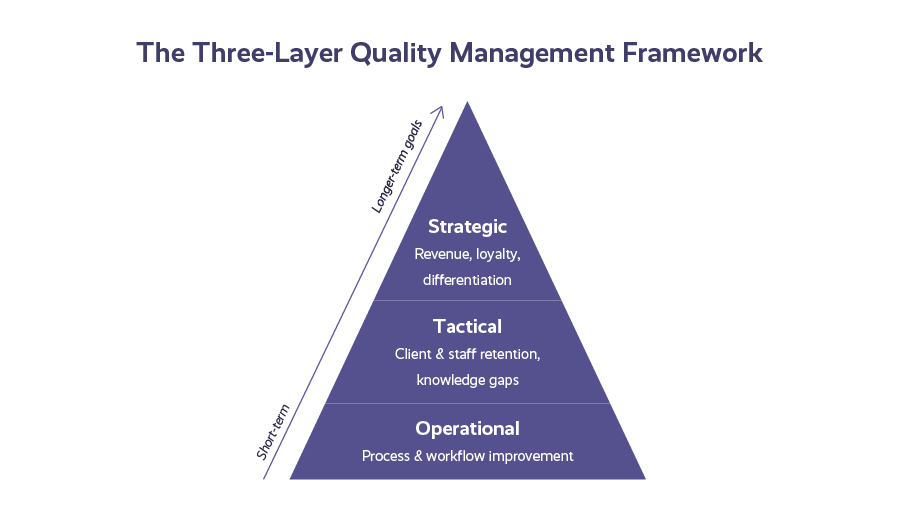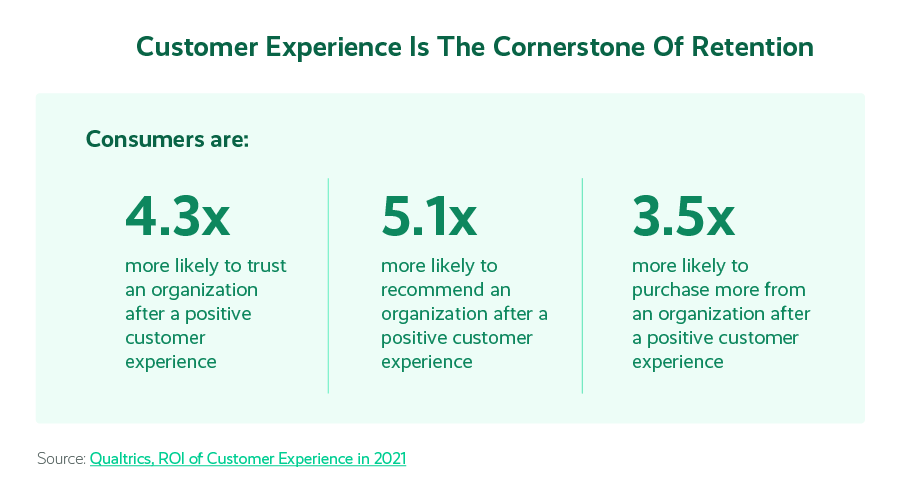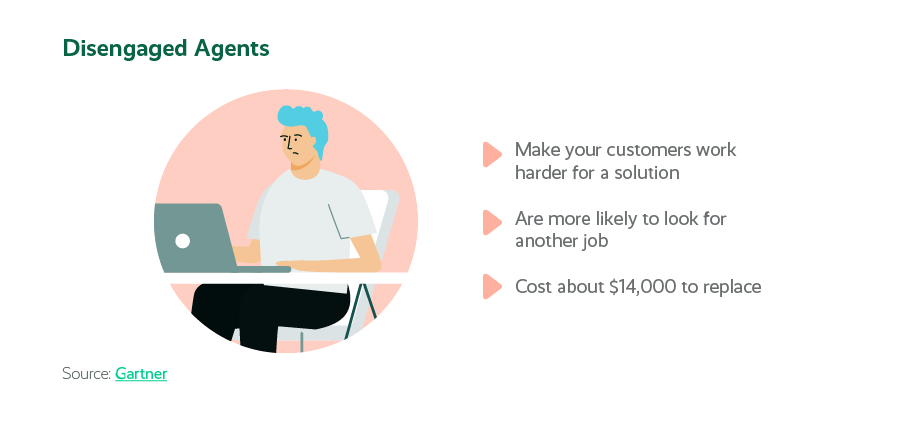How To Preserve Your Contact Center QM Budget
With corporate budgets tightening, contact center leaders might be tempted to cut into your quality management funding.
But quality management is a vital area of your business — it’s what ensures your customers get top-notch service. If they don’t get it, they’re likely to move on, costing your business money in the long run.
A 2021 Qualtrics study spanning 17 industries found that, on average, organizations risk losing 9.5% of their revenue due to bad experiences. That in itself makes a strong case for keeping your contact center quality management budget intact, but the effects of a strong program go far beyond revenue.
What Is A Quality Management Program?
A leap beyond traditional quality assurance, a quality management (QM) program is a comprehensive initiative that targets managing a high standard of service in a service center through prediction and prevention.
While a traditional quality assurance program means evaluating interactions and checking for compliance, QM takes a more holistic approach by going beyond typical contact center metrics and looking at an agent’s behaviors in both subjective and objective ways. Beyond evaluation scores, it also focuses on coaching and includes processes to maintain the integrity of the feedback, like calibration.
With sky-high customer expectations and the increasing use of digital channels, keeping service quality high is no easy task. It requires a multi-level approach to ensure success today and in the years ahead.
Three Vital Layers Of Quality Management
QM is far more than just reviewing customer interactions for areas of concern. It’s a layered approach that gives you deeper insights into customer service to help you tackle immediate issues alongside long-term goals. With a full investment in quality management, your customer support center can keep KPIs, customer retention, and revenue on track and become a mainstay of customer experience.

The operational level is your day-to-day concerns — looking for key trends, keeping service levels in check, identifying customer service agents who need coaching sessions, and measuring agent productivity, performance, development, and improvement.
The tactical level of quality management is all of your mid-range issues like improving client retention, reducing agent attrition, uncovering and addressing the root causes of poor performance, and motivating agents to improve.
The strategic level involves all the elements that make your organization truly stand out among the competition. Increasing revenue, capturing customer loyalty, and building the ROI of your contact center technology investments are all examples of long-term strategies you should be working toward.
It’s not enough to stick to managing quality at the operational level. To stay ahead of the competition and support revenue growth, you need an approach built for the long haul.
Related Article: Why Sweaty Betty Doesn’t Sweat Quality Management
Impact Of Quality Management On Customer Retention
Poor experiences send customers out the door, and it’s vastly more expensive to acquire new customers than to hang on to the ones you have. That makes customer retention an essential part of your financial plan — and your digital customer service strategy. But what’s the real value of a loyal customer?
Qualtrics examined three key aspects of consumer loyalty to a company: trust, advocacy, and ongoing purchases. Providing a positive customer experience was found to have a significant impact on all three aspects.

Trust
The Qualtrics study found that 89% of customers who had a high-quality customer service experience trusted the company afterward. Building customer trust has a tremendous impact on your bottom line — Harvard Business Review found that trusted companies outperform their peers by up to 400% in total market value. Trust is the core of your customers’ loyalty and supports the next two aspects.
Advocacy
The study showed that 88% of consumers were likely to recommend an organization after a very good experience — and only 17% after a poor experience. When a customer trusts a company, they feel comfortable recommending it to people they know.
Also consider that 46% of consumers have called out a brand on social media — meaning a poor experience can instantly go far beyond a customer’s friends, relatives, and neighbors to reach a global audience.
Your quality management approach can make or break advocacy. Seek out a QM solution that lets you customize scorecards to examine interactions for speed, completeness, and customer sentiment. This will help you gauge whether your team is delivering seamless experiences that turn customers into your brand champions.
Strong customer advocacy not only helps you retain your customers but also add new ones, further strengthening revenues.
Future Purchases
While Qualtrics found that additional purchases weren’t influenced as strongly by a positive customer experience as the other two factors of customer loyalty, there was still a significant impact. The study found a 61-point gap between the likelihood to purchase more after a five-star experience than after a one- or two-star encounter.
Purchases are influenced by more than just customer experience quality — budget and other priorities are important factors that are out of your agents’ control. But your service center can’t afford to tip the scales in the other direction. Don’t forget that bad experiences cost businesses an average of 9.5% of revenue.
Related eBook: Three Steps To Creating A Winning Customer Experience Strategy
Impact Of Quality Management On Agent Engagement
The employee experience is a vital part of customer interaction success. Agent engagement should be a top priority for your CX center. From customer experience to attrition, the engagement level of your team is critical to your customer service success — and revenue.

Agent Engagement And Customer Experience
It’s no secret that engaged agents are more productive than disengaged employees. Gartner found that disengaged agents also deliver worse customer experiences, such as increasing customer effort for a resolution or failing to resolve customer issues on first contact.
The strongest predictor of agent disengagement in the study was the lack of clear roles and goals for agents. Agents were 90% more likely to become disengaged when they weren’t sure leadership wanted them to work toward or prioritize.
Be clear with your agents about what’s most important in your customer experience. Should they prioritize response time or quality? Should they stick with a customer through the resolution of their issue or hand them off to another department? This guidance reduces friction for the agent when they’re in a tough situation, improving customer satisfaction at the same time.
The right quality management solution will ensure that your agents have clear, key goals to achieve and receive useful feedback and coaching when they don’t.
Agent Engagement and Turnover
Gartner’s study found that 38% of agents are disengaged and 84% of those agents are likely to be looking for another job. That translates to about 32% of your agent workforce that could turn over. At $14,113 to replace an agent, attrition is a costly issue.
Giving agents quick feedback on their performance is one of the strongest actions you can take to combat disengagement and, in turn, agent attrition. A Gallup study found that employees who receive frequent, meaningful feedback are almost four times more likely than other employees to be engaged.
Employees no longer want to wait for annual or even quarterly reviews to find out how they’re doing. A strong quality management solution lets you quench agents’ thirst for feedback by ensuring your quality analysts and contact center managers get a steady, regular stream of interactions — across all channels — to examine and provide guidance on. When agents find out what they can improve on quickly and are able to act on it immediately, they stay engaged and your entire customer experience improves in response.
Keep Investing In Quality Management To Stay Ahead Of The Competition
You can’t manage what you can’t measure, so maintaining a solid budget for quality management should be a top priority for every customer support center. You’re more likely to keep customer experience up and agent turnover down, providing a strong ROI for your investment in a quality management program. Invest in a contact center software solution that offers a fully integrated approach to quality to help save you time and be more efficient.
Read more about quality management strategy in our ebook, The QM Success Blueprint: Improve & Monitor Your Contact Center Agents, or request a demo of Playvox Quality Management to discover the impact it could make in your contact center.







